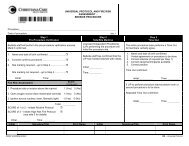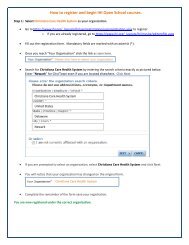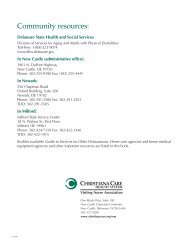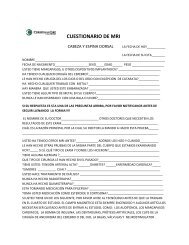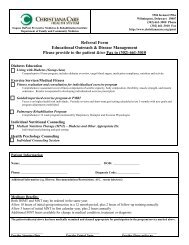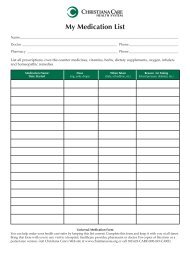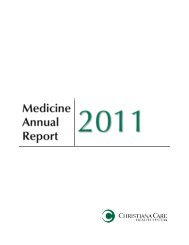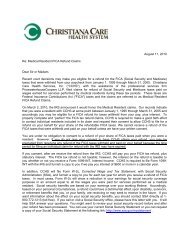Nutrition - Christiana Care Health System
Nutrition - Christiana Care Health System
Nutrition - Christiana Care Health System
You also want an ePaper? Increase the reach of your titles
YUMPU automatically turns print PDFs into web optimized ePapers that Google loves.
<strong>Nutrition</strong>
Table of Contents<br />
An Overall Heart <strong>Health</strong>y Lifestyle . . . . . . . . . . . . . . . . . . . . . . . . . . . . . . . . . . . . . . . . . . . . . . 3<br />
Recommended Daily Intakes . . . . . . . . . . . . . . . . . . . . . . . . . . . . . . . . . . . . . . . . . . . . . . . . . . 4<br />
<strong>Health</strong>y Eating Plate . . . . . . . . . . . . . . . . . . . . . . . . . . . . . . . . . . . . . . . . . . . . . . . . . . . . . . . . . 5<br />
Mediterranean Diet Pyramid . . . . . . . . . . . . . . . . . . . . . . . . . . . . . . . . . . . . . . . . . . . . . . . . . . 6<br />
Characteristics of the Mediterranean Diet . . . . . . . . . . . . . . . . . . . . . . . . . . . . . . . . . . . . . . . . 7<br />
DASH Diet (especially for hypertension). . . . . . . . . . . . . . . . . . . . . . . . . . . . . . . . . . . . . . . . . 10<br />
Good Fat — Bad Fat . . . . . . . . . . . . . . . . . . . . . . . . . . . . . . . . . . . . . . . . . . . . . . . . . . . . . . . . . 11<br />
Choose the Leanest Proteins . . . . . . . . . . . . . . . . . . . . . . . . . . . . . . . . . . . . . . . . . . . . . . . . . . 13<br />
Spreads . . . . . . . . . . . . . . . . . . . . . . . . . . . . . . . . . . . . . . . . . . . . . . . . . . . . . . . . . . . . . . . . . . 14<br />
Omega-3 Fatty Acids . . . . . . . . . . . . . . . . . . . . . . . . . . . . . . . . . . . . . . . . . . . . . . . . . . . . . . . 16<br />
Fiber . . . . . . . . . . . . . . . . . . . . . . . . . . . . . . . . . . . . . . . . . . . . . . . . . . . . . . . . . . . . . . . . . . . . 17<br />
Sodium Smart . . . . . . . . . . . . . . . . . . . . . . . . . . . . . . . . . . . . . . . . . . . . . . . . . . . . . . . . . . . . . 18<br />
Sodium-free Flavoring Tips . . . . . . . . . . . . . . . . . . . . . . . . . . . . . . . . . . . . . . . . . . . . . . . . . . 19<br />
Sugar Savvy . . . . . . . . . . . . . . . . . . . . . . . . . . . . . . . . . . . . . . . . . . . . . . . . . . . . . . . . . . . . . . 20<br />
Reading Food Labels. . . . . . . . . . . . . . . . . . . . . . . . . . . . . . . . . . . . . . . . . . . . . . . . . . . . . . . . 21<br />
Cooking Tips and Recipe Substitutions . . . . . . . . . . . . . . . . . . . . . . . . . . . . . . . . . . . . . . . . . . 22<br />
Dining Out . . . . . . . . . . . . . . . . . . . . . . . . . . . . . . . . . . . . . . . . . . . . . . . . . . . . . . . . . . . . . . . 23<br />
2
An Overall Heart<br />
<strong>Health</strong>y Lifestyle<br />
1. Don’t smoke<br />
2. Maintain a healthy weight*<br />
3. Engage in regular physical activity<br />
4. Eat a healthy diet*<br />
5. Manage blood pressure*<br />
6. Take charge of cholesterol*<br />
7. Keep blood sugar or glucose at<br />
healthy levels*<br />
diet-related*<br />
3
Recommended<br />
Daily Intakes<br />
NUTRIENT<br />
RECOMMENDED<br />
INTAKE<br />
1,500 KCAL<br />
CALORIES<br />
2,000<br />
CALORIES<br />
Total Fat<br />
25% — 35% calories<br />
41 - 58 grams<br />
55 - 77 grams<br />
Saturated Fat<br />
< 7% calories<br />
< 11 grams<br />
< 15 grams<br />
Trans Fat<br />
< 1% calories<br />
0 — 1.5 grams<br />
0 - 2 grams<br />
Polyunsaturated Fat<br />
up to 10% calories<br />
< 16 grams<br />
< 22 grams<br />
Monounsaturated Fat<br />
up to 20% calories<br />
< 33 grams<br />
< 44 grams<br />
Fiber<br />
25 — 35 grams<br />
(10 grams of soluble fiber)<br />
Sodium<br />
< 1,500 mg<br />
Cholesterol<br />
< 200 mg<br />
Added Sugar<br />
6 tsp for women (< 24 grams)<br />
9 tsp for men (< 36 grams)<br />
Alcohol<br />
(optional)<br />
1 drink* for women<br />
2 drinks for men<br />
* 1 drink = 12 oz beer = 5 oz wine = 1 oz hard liquor Source: American Heart Association<br />
4
<strong>Health</strong>y Eating Plate<br />
<strong>Health</strong>y Oils<br />
Use healthy oils (like<br />
olive and canola oil)<br />
for cooking, on salad,<br />
and at the table. Limit<br />
butter. Avoid trans fat.<br />
Water<br />
Drink water, tea, or coffee<br />
(with little or no sugar).<br />
Limit juice (1 small glass/day).<br />
Avoid sugary drinks.<br />
Eat plenty of<br />
fruits of<br />
all colors.<br />
Eat whole grains (like<br />
brown rice, wholewheat<br />
bread, and<br />
whole-grain pasta).<br />
Limit refined<br />
grains (like<br />
white rice and<br />
white bread).<br />
The more veggies—<br />
and the greater the<br />
variety—the better.<br />
Fried potatoes and<br />
french fries don’t count.<br />
Choose fish,<br />
poultry, beans,<br />
and nuts; limit red<br />
meat, bacon, cold cuts,<br />
and other processed meats.<br />
Stay Active!<br />
Source: www.hsps.harvard.edu/nutritionsource<br />
5
Mediterranean Diet<br />
Pyramid<br />
A contemporary approach to delicious, healthy eating<br />
6
Characteristics of the<br />
Mediterranean Diet<br />
Traditional Mediterranean meals feature foods grown all around the Mediterranean Sea. Easily adaptable to<br />
today's kitchens and busy lives, they include:<br />
1. Grains, vegetables, and fruits should be eaten at most meals,<br />
because they are important sources of vitamins, minerals, energy,<br />
antioxidants, and fiber. An eating pattern high in these foods promotes<br />
good health and weight control when consumed wisely.<br />
Grains. The majority of grains should be whole grains, such as wheat,<br />
oats, rice, rye, barley, and corn. These grains are best consumed in<br />
whole, minimally-processed forms. Refining and processing can remove<br />
many valuable nutrients including vitamins, minerals, and fiber.<br />
Vegetables. Vegetables are an important staple of eating patterns of<br />
peoples in all the countries bordering the Mediterranean Sea, providing<br />
valuable nutrients. These benefits are amplified because the vegetables<br />
are normally cooked or drizzled with olive oil. Raw vegetables are<br />
also a healthy vegetable option.<br />
Fruits. Whole fresh fruit is ever-present in the Mediterranean.<br />
No-sugar-added fruit juices provide only some of the same nutrition<br />
benefits as whole fruit, and attention to portion control and total<br />
calories is wise. Fruit "drinks" do not have the benefits of fruit juice.<br />
2. Olives and olive oil are central to the Mediterranean diet. Olives<br />
are universally eaten whole, and widely used for cooking and flavoring<br />
in the countries that border the Mediterranean Sea. Olive oil is the<br />
principal source of dietary fat used for cooking, baking, and for dressing<br />
salads and vegetables. Extra virgin olive oil is highest in health-promoting<br />
fats, phytonutrients, and other important micronutrients.<br />
3. Nuts, beans, legumes and seeds are good sources of healthy<br />
fats, protein, and fiber. They add flavor and texture to<br />
Mediterranean dishes.<br />
4. Herbs and spices add flavors and aromas to foods, reducing the<br />
need to add salt or fat when cooking. They are also rich in a broad<br />
range of health-promoting antioxidants, and are used liberally in<br />
Mediterranean cuisines. Herbs and spices also contribute to the national<br />
identities of the various Mediterranean cuisines.<br />
7
Characteristics of the Mediterranean Diet<br />
5. Cheese and yogurt are eaten regularly in the traditional<br />
Mediterranean diet in moderate amounts. The calcium in cheese<br />
and yogurt is important for bone and heart health. Low fat<br />
and nonfat dairy products are suggested to reduce saturated<br />
fat intake.<br />
6. Fish and shellfish are important sources of healthy protein for<br />
Mediterranean populations. Fish such as tuna, herring, sardines and<br />
salmon are rich in heart-healthy omega-3 fatty acids, and shellfish<br />
and crustaceans including mussels, clams and shrimp have<br />
similar benefits. Fish and shellfish are not typically battered and<br />
fried in Mediterranean countries.<br />
7. Eggs are a good source of high-quality protein, and can be especially<br />
beneficial for individuals who do not eat meat. Eggs are regularly used<br />
in baking in Mediterranean countries.<br />
8. Meats are eaten in small portions by Mediterranean peoples, who<br />
prefer lean cuts. Poultry is a good source of lean protein without the high<br />
levels of saturated fat found in some cuts of red meat. With ground<br />
meats, 93 percent lean/7 percent fat is a sound choice.<br />
9. Sweets are consumed in small portions in the Mediterranean.<br />
Fruits are ever-present on Mediterranean tables, and are a normal way<br />
to end a meal. Gelato and sorbet are consumed a few times a week, in<br />
small portions.<br />
10. Wine is consumed regularly but moderately in the Mediterranean,<br />
unless discouraged by religious beliefs. “Moderately” means up to one<br />
five-ounce glass of wine per day for women and up to two five-ounce<br />
glasses for men. Individuals should only drink wine if they are medically<br />
able to do so, and should ask their doctors for more information.<br />
11. Water is essential for life, and proper hydration during each day<br />
makes a positive contribution to health, well being and energy levels.<br />
Individual variations in body sizes, metabolic rates and activity levels<br />
mean that some people should drink more water every day than others.<br />
8
Characteristics of the Mediterranean Diet<br />
12. Portion size. Because foods in the bottom section of the pyramid<br />
may be eaten in larger amounts and more frequently, portion sizes and<br />
frequency of consumption decline in the pyramid’s upper sections.<br />
13. Moderation is a wise approach. A balanced and healthy diet<br />
accommodates most foods and drinks, so long as moderation and wise<br />
choices are the key characteristics. For example, enjoying a small piece<br />
of birthday cake, savoring a few slices of grilled steak, or relaxing with<br />
family and friends with a glass or two of wine or beer are important<br />
aspects of being human. As always, moderation is key.<br />
14. <strong>Health</strong>y lifestyle habits. Daily physical activity is important for<br />
overall good health. This includes strenuous exercise like running and<br />
aerobics, as well as more leisurely activities such as walking and<br />
housework or yard-work, or taking the stairs instead of the elevator.<br />
15. Meals in the company of others. The Mediterranean Diet is<br />
grounded on the principles of enjoyment and pleasure. Foods, drinks<br />
and meals are best eaten with others, when possible, and savored.<br />
9
The DASH Diet<br />
This eating plan is from the "Dietary Approaches to Stop Hypertension" (DASH) clinical study supported<br />
by the National Institutes of <strong>Health</strong>. The DASH combination diet lowered blood pressure.<br />
FOOD<br />
GROUP<br />
DAILY SERVINGS<br />
1,500<br />
CALORIES<br />
2,000<br />
CALORIES<br />
SERVING SIZES<br />
EXAMPLES<br />
AND NOTES<br />
SIGNIFICANCE<br />
OF EACH<br />
FOOD GROUP<br />
Grains & grain<br />
products<br />
5-6<br />
7-8<br />
1 slice bread<br />
1/2 C dry cereal<br />
1/2 C cooked rice,<br />
pasta, or cereal<br />
whole wheat bread, English<br />
muffin, pita bread, bagel,<br />
cereals, grits, oatmeal<br />
major sources<br />
of energy<br />
and fiber<br />
Vegetables<br />
3-4<br />
4-5<br />
1 C raw leafy vegetable<br />
1/2 C cooked vegetable<br />
6 oz vegetable juice<br />
tomatoes, potatoes, carrots,<br />
peas, squash, broccoli,<br />
turnip greens, collards,<br />
kale, spinach, artichokes,<br />
sweet potatoes, beans<br />
rich sources of<br />
potassium,<br />
magnesium,<br />
and fiber<br />
Fruits<br />
3-4<br />
4-5<br />
6 oz fruit juice<br />
1 medium fruit<br />
1/4 C dried fruit<br />
1/2 C fresh, frozen, or<br />
canned fruit<br />
apricots, bananas, dates,<br />
oranges, orange juice,<br />
grapefruit, grapefruit juice,<br />
mangoes, melons, peaches,<br />
pineapples, prunes, raisins,<br />
strawberries, tangerines<br />
important sources<br />
of potassium,<br />
magnesium,<br />
and fiber<br />
Low fat or<br />
nonfat dairy<br />
foods<br />
2-3<br />
2-3<br />
8 oz milk<br />
1 C yogurt<br />
1.5 oz cheese<br />
skim or 1% milk, skim or<br />
low fat buttermilk, nonfat<br />
or lowfat yogurt, part<br />
skim mozzarella cheese,<br />
nonfat cheese<br />
major sources<br />
of calcium and<br />
protein<br />
Meats, poultry,<br />
and fish<br />
2 or less<br />
2 or less<br />
3 oz cooked meats,<br />
poultry, or fish<br />
select only lean; trim away<br />
visible fats; broil, roast, or<br />
boil, instead of frying;<br />
remove skin from poultry<br />
rich sources of<br />
protein and<br />
magnesium<br />
Nuts, seeds,<br />
and legumes<br />
3-4 per<br />
week<br />
4-5 per<br />
week<br />
1.5 oz or 1/3 C nuts<br />
1/2 oz or 2 Tbsp seeds<br />
1/2 C cooked legumes<br />
almonds, filberts, mixed<br />
nuts, peanuts, walnuts,<br />
sunflower seeds, kidney<br />
beans, lentils<br />
rich sources<br />
of energy,<br />
magnesium,<br />
potassium,<br />
protein, and fiber<br />
10
Good Fat – Bad Fat<br />
Why follow a cardiac diet?<br />
Saturated fats, trans fat and dietary cholesterol<br />
raise bad cholesterol levels in your blood. Blood<br />
cholesterol may build up and cause blockages in<br />
your blood vessels. This is why a diet low in<br />
saturated fat, trans fat and cholesterol is good<br />
for your heart.<br />
Fat: It’s not all bad<br />
Fats are essential to good health. They provide<br />
storage for extra calories, insulate and cushion<br />
organs, help build cell membranes, make<br />
hormones and aid in absorption and the<br />
transport of vitamins A, D, E, and K.<br />
What you may not know is this: Not all fats<br />
are created equal.<br />
Saturated fats in food can be bad.<br />
They can raise the level of “bad” cholesterol (LDL)<br />
in your blood. Cholesterol is a soft, fat-like, waxy<br />
substance found in the bloodstream and in all<br />
your body's cells. Too much bad cholesterol in the<br />
blood is a major risk for coronary heart disease.<br />
Unsaturated fats in food can be good.<br />
They can lower the “bad” cholesterol levels in<br />
your blood and help build “good” cholesterol<br />
(HDL), which seems to protect against heart<br />
disease. Unsaturated fats are found in large<br />
amounts in plant foods and they are usually<br />
liquid at room temperature.<br />
Changing the fat content of your meals to<br />
eliminate saturated sources and include<br />
unsaturated sources can usually lower<br />
your bad (LDL) cholesterol and sometimes<br />
raise your good (HDL) cholesterol.<br />
Here’s your guide to limiting bad fats and<br />
including good fats in your diet:<br />
Limit Bad Fats—Both saturated and trans fats<br />
raise your blood cholesterol levels more than<br />
anything else in your diet.<br />
Saturated fats can be avoided by limiting:<br />
■ Butter, cheese, ice cream, whole and 2% milk.<br />
■ Red meat and poultry skin.<br />
■ Palm and coconut oils.<br />
■ Margarine and shortening.<br />
Trans fats, which are formed when liquid oils are<br />
solidified, can be avoided by limiting:<br />
■ Hydrogenated vegetable oils, margarine<br />
and shortening.<br />
■ Deep-fried foods.<br />
■ Store-bought cookies, cakes, and pastries.<br />
Include Good Fats, both monounsaturated and<br />
polyunsaturated fats.<br />
Monounsaturated fats can be found in:<br />
■ Olive, canola and peanut oil.<br />
■ Pecans, hazelnuts, pistachios, peanuts<br />
and almonds.<br />
■ Avocados.<br />
Polyunsaturated fats can be found in:<br />
■ Vegetable oils, such as corn, sunflower seed,<br />
safflower and soybean oil.<br />
■ Walnuts, pine nuts and seeds.<br />
11
Good Fat – Bad Fat<br />
A special type of polyunsaturated fat known as<br />
omega-3 fats can be found in:<br />
■<br />
Fatty fish (such as salmon, mackerel, trout,<br />
tuna and sardines).<br />
Diets including omega-3 fats have been shown to<br />
lower heart disease risk. Aim for 2 three-ounce<br />
servings of fatty fish per week.<br />
Triglycerides<br />
What are triglycerides?<br />
Triglycerides are a form of fat found in the<br />
bloodstream that are composed of fatty acids<br />
and glycerol. They are completely different<br />
from cholesterol. When you eat a meal, your<br />
triglyceride level increases significantly, as it is<br />
a measure of any fat you have eaten. High levels<br />
of triglycerides combined with high cholesterol<br />
levels can increase your risk of coronary artery<br />
disease and heart attacks.<br />
How are triglyceride levels measured?<br />
A simple blood test is used to measure your<br />
triglyceride levels. It is very important that<br />
triglyceride readings be performed after a<br />
12 to 14 hour fast.<br />
For adults, fasting triglyceride levels should be<br />
less than 150 mg/dl. If the levels are higher,<br />
this signifies that you may be consuming too<br />
much sugary food, too many calories or fat, or<br />
excessive alcohol. Reduced physical activity,<br />
prediabetes and uncontrolled diabetes also can<br />
cause elevated triglycerides.<br />
What steps are necessary to lower<br />
triglyceride levels?<br />
1. Lose weight if you are overweight.<br />
Excess body weight can elevate triglyceride<br />
levels. Reduce portion sizes and increase<br />
intake of fresh fruits and vegetables.<br />
2. Exercise regularly.<br />
Engaging in physical activity for at least 30<br />
minutes most days of the week will raise HDL<br />
(good) cholesterol, help you to lose weight and<br />
lower triglyceride levels.<br />
3. Limit sweets.<br />
Cakes, cookies, fruit juice, soda and other<br />
sweetened items can raise triglyceride levels.<br />
4. Eat less saturated fat.<br />
Limit butter, red meat, regular cheese, whole milk<br />
and 2% milk. Choose poultry, fish, skim<br />
or 1% milk and low-fat cheese.<br />
5. Consume omega-3 fatty acids.<br />
Omega-3 fatty acids in doses of two to four grams<br />
per day can help to lower triglyceride levels. Good<br />
sources of omega-3 fatty acids include fatty fish, but<br />
these high doses generally require supplements. Be<br />
sure to consult your doctor first.<br />
6. Limit alcohol.<br />
Alcohol can stimulate the liver to produce<br />
triglycerides. Limit alcohol to one drink per day<br />
for women and two drinks per day for men.<br />
12
Choose the<br />
Leanest Proteins<br />
Make most of your choices from above the bold line.<br />
MEAT & POULTRY<br />
(4 oz. cooked, fat trimmed, no<br />
skin unless otherwise noted)<br />
CALORIES<br />
SATURATED<br />
FAT (g)<br />
TOTAL<br />
FAT (g)<br />
CHOLESTEROL<br />
(mg)<br />
SODIUM<br />
(mg)<br />
1X/MONTH 1X/WEEK DAILY<br />
Tuna, water packed<br />
Turkey breast<br />
Ground turkey breast, white meat only<br />
Crab Meat<br />
Flounder<br />
Veggie Burger (Soy protein)<br />
Lobster<br />
Shrimp<br />
Ham, Hatfield, extra lean, low salt (2 oz)<br />
Chicken breast<br />
Salmon<br />
Egg, 1 whole<br />
Venison<br />
Turkey bacon, 4 slices (1 oz)<br />
Pork Tenderloin / Boneless Loin<br />
Cabot 50% red fat cheddar cheese (1 oz)<br />
Cheese (Mozzarella-part skim) (1 oz)<br />
Ground beef, >95% lean<br />
\ Turkey, dark meat<br />
Veal chop, loin<br />
Beef top round<br />
Beef flank<br />
Ground turkey meat<br />
Chicken, dark meat<br />
Crab cake, broiled<br />
Filet Mignon<br />
Lamb Chop, loin<br />
Cheese (Mozz, Cheddar, American) (1 oz)<br />
Ground Chicken meat<br />
Bacon, 4 slices (1 oz)<br />
Scrapple, 2 large slices (3 oz)<br />
Steak, T-bone<br />
Sausage, 2 links (2 oz)<br />
Ham, roasted<br />
Pork chop (loin)<br />
Ground beef, 90% lean<br />
Corned beef<br />
Ground beef,
Spreads<br />
Choose spreads that are free of partially hydrogenated oil and have ≤ 1.5 grams of saturated fat per tablespoon<br />
(bolded items).<br />
TUBS AND SQUEEZES (1 TBS.)<br />
(made without partially hydrogenated oil)<br />
CALORIES<br />
SATURATED<br />
FAT (g)<br />
TRANS<br />
FAT (g)<br />
SODIUM<br />
(mg)<br />
\<br />
Promise Activ Light Spread<br />
Promise Light Buttery Spread<br />
I Can’t Believe It’s Not Butter Squeeze<br />
I Can’t Believe It’s Not Butter Light with Olive Oil<br />
I Can’t Believe It’s Not Butter Light<br />
I Can’t Believe It’s Not Butter with Calcium & Vitamin D<br />
Brummel & Brown Vegetable Oil Spread<br />
Country Crock Light<br />
Smart Balance Light<br />
Country Crock with Calcium & Vitamin D<br />
Promise Buttery Spread<br />
Olivio Original Spread<br />
Land O’ Lakes Light Butter with Canola Oil<br />
Best Life Buttery Spread<br />
Smart Balance with Extra Virgin Olive Oil<br />
Best Life with Extra Virgin Olive Oil<br />
Country Crock Churn Style<br />
I Can’t Believe It’s Not Butter Original<br />
I Can’t Believe It’s Not Butter with Olive Oil<br />
Country Crock Original<br />
Smart Balance Original<br />
Smart Balance with Calcium & Vitamin D<br />
Smart Balance Organic<br />
Land O’ Lakes Whipped Butter<br />
Land O’ Lakes Butter with Olive Oil<br />
Land O’ Lakes Butter with Canola Oil<br />
Kellers Salted Whipped Butter<br />
Breakstones Salted Whipped Butter<br />
TUBS (1 TBS.)<br />
(made with partially hydrogenated oil)<br />
Benecol Light<br />
Fleischmann’s Original<br />
Benecol Spread<br />
Parkay Fresh & Creamy<br />
Land O’ Lakes Fresh Buttery Taste Spread<br />
45<br />
45<br />
60<br />
45<br />
45<br />
45<br />
45<br />
50<br />
50<br />
50<br />
80<br />
80<br />
50<br />
50<br />
60<br />
60<br />
60<br />
70<br />
70<br />
70<br />
80<br />
80<br />
80<br />
50<br />
90<br />
100<br />
70<br />
70<br />
50<br />
60<br />
70<br />
70<br />
70<br />
0.5<br />
1<br />
1<br />
1.5<br />
1.5<br />
1.5<br />
1.5<br />
1.5<br />
1.5<br />
1.5<br />
1.5<br />
1.5<br />
2<br />
2<br />
2<br />
2<br />
2<br />
2<br />
2<br />
2<br />
2.5<br />
2.5<br />
2.5<br />
3.5<br />
4<br />
4<br />
4.5<br />
4.5<br />
0.5<br />
1<br />
1<br />
1.5<br />
2<br />
0<br />
0<br />
0<br />
0<br />
0<br />
0<br />
0<br />
0<br />
0<br />
0<br />
0<br />
0<br />
0<br />
0<br />
0<br />
0<br />
0<br />
0<br />
0<br />
0<br />
0<br />
0<br />
0<br />
0<br />
0<br />
0<br />
0<br />
0<br />
NA<br />
NA<br />
NA<br />
NA<br />
NA<br />
85<br />
85<br />
80<br />
85<br />
85<br />
90<br />
90<br />
90<br />
90<br />
95<br />
85<br />
95<br />
90<br />
100<br />
70<br />
100<br />
85<br />
90<br />
90<br />
100<br />
90<br />
90<br />
100<br />
50<br />
90<br />
85<br />
55<br />
55<br />
CALORIES SATURATED TRANS SODIUM<br />
FAT (g) FAT (g) (mg)<br />
110<br />
85<br />
110<br />
80<br />
80<br />
NA indicates that label shows 0 grams trans fat, but probably contains 0.3 to 0.49 grams.<br />
14
Spreads<br />
COOKING AND BAKING SPRAYS<br />
CALORIES<br />
SATURATED<br />
FAT (g)<br />
TRANS<br />
FAT (g)<br />
SODIUM<br />
(mg)<br />
Olivio Buttery Spray (5 pumps)<br />
I Can’t Believe It’s Not Butter Original Spray (5 pumps)<br />
Pam Original Spray (1 sec)<br />
Smart Balance Omega Spray (1 sec)<br />
STICKS (1 TBS.)<br />
0<br />
0<br />
0<br />
10<br />
CALORIES<br />
0<br />
0<br />
0<br />
0<br />
SATURATED<br />
FAT (g)<br />
0<br />
0<br />
0<br />
0<br />
TRANS<br />
FAT (g)<br />
15<br />
0<br />
0<br />
0<br />
SODIUM<br />
(mg)<br />
I Can’t Believe It’s Not Butter All-purpose<br />
Smart Balance Buttery Stick<br />
Kellers Salted Butter<br />
Plugra Salted Butter<br />
Breakstones Salted Butter<br />
Land O’ Lakes Salted Butter<br />
Wild Harvest Salted Butter<br />
Parkay Fresh & Creamy<br />
Blue Bonnet<br />
Imperial Veg. Oil Blend Stick<br />
Fleischmann’s Original<br />
100<br />
100<br />
100<br />
100<br />
100<br />
100<br />
100<br />
80<br />
70<br />
70<br />
80<br />
3.5<br />
5<br />
7<br />
7<br />
7<br />
7<br />
7<br />
1.5<br />
1.5<br />
1.5<br />
2<br />
0<br />
0<br />
0<br />
0<br />
0<br />
0<br />
0<br />
1.5<br />
1.5<br />
1.5<br />
1.5<br />
95<br />
100<br />
90<br />
90<br />
90<br />
95<br />
75<br />
130<br />
125<br />
105<br />
110<br />
15
Omega-3 Fatty Acids<br />
Benefits<br />
■ Decrease risk of heart disease, heart attacks,<br />
and stroke.<br />
■ Protect against irregular heartbeats that can<br />
cause cardiac-related death.<br />
■ Reduce triglycerides.<br />
■ May help reduce blood pressure.<br />
■ Keep HDL (good) cholesterol high.<br />
■ Reduce inflammation.<br />
■ May reduce pain of rheumatoid arthritis.<br />
■ Associated with lower rates of depression.<br />
Source – primarily fatty fish<br />
HOW MUCH DO YOU NEED?<br />
Eat fatty fish 2 times per week<br />
(3 oz. cooked = 1 portion)<br />
TYPE OF FISH<br />
Anchoivies, Herring, Atlantic Mackerel, Alaskan Salmon<br />
Albacore tuna, sablefish, sardines<br />
Bluefin tuna, trout<br />
Halibut<br />
Fresh water bass, oysters<br />
Sea bass<br />
Shrimp, Pollock<br />
SERVING SIZE PROVIDES 1.5 g<br />
OF OMEGA-3 FATTY ACIDS<br />
1 serving (3 oz)<br />
1 ¼ servings (3.75 oz)<br />
1 ½ servings (4.5 oz)<br />
2 servings (6 oz)<br />
2 ½ servings (7.5 oz)<br />
3 servings (9 oz)<br />
3 ½ servings (10.5 oz)<br />
16
Fiber<br />
Dietary fiber is the naturally occurring material<br />
in food that is not digested by humans.<br />
HOW MUCH DO YOU NEED?<br />
25 – 35 grams daily<br />
(10 grams should be soluble fiber)<br />
Look for ≥ 3 grams of fiber/serving<br />
Soluble fiber can be found in fruits (such as<br />
apples, oranges and grapefruit), vegetables,<br />
legumes (such as dry beans, lentils and peas),<br />
barley, and oats.<br />
■<br />
■<br />
May moderate blood sugar.<br />
May lower LDL “bad” cholesterol by 1% for<br />
every 1-2 grams consumed each day.<br />
SIMPLE WAYS TO ADD FIBER TO YOUR DIET<br />
INSTEAD OF<br />
White breads/regular pastas<br />
White rice<br />
Mashed or fried potatoes<br />
Fruit juices or canned fruit<br />
Potato chips<br />
Refined cereals<br />
White flour<br />
Meat, fish or poultry<br />
Aim for 5 Fruits and Vegetables Daily<br />
SUBSTITUTE<br />
Whole wheat breads/pastas<br />
Brown rice<br />
Baked potato with skin<br />
Fresh or dried fruits<br />
Popcorn<br />
Bran cereals/oatmeal<br />
Whole-wheat flour<br />
Lentils/beans<br />
17
Sodium Smart<br />
Too much sodium can contribute to high blood<br />
pressure—a major risk factor for heart disease.<br />
Sodium makes the body hold on to extra water.<br />
This extra fluid may cause shortness of breath<br />
and fluid buildup in the legs, ankles, stomach or<br />
lungs and make the heart work harder.<br />
RECOMMENDATION<br />
≤ 1500 mg sodium / day<br />
1 tsp of salt = 2,300 mg of sodium<br />
Look for an entrée with
Sodium-free<br />
Flavoring Tips<br />
When cooking, the following items may be used<br />
for flavoring instead of salt or seasonings that<br />
contain sodium.<br />
Remember: A little bit of spice goes a long way.<br />
Be careful not to over-season.<br />
Spice Blend Recipe (makes about 1/3 cup)<br />
■ 5 tsp onion powder<br />
■ 2 ½ tsp garlic powder<br />
■ 2 ½ tsp paprika<br />
■ 2 ½ tsp dry mustard<br />
■ 1 ½ tsp crushed thyme leaves<br />
■ ½ tsp white pepper<br />
TYPE OF FOOD<br />
Beef<br />
Chicken<br />
Eggs<br />
Fish<br />
Lamb<br />
Pork<br />
Veal<br />
Vegetables<br />
Desserts<br />
FLAVORINGS THAT WORK WELL WITH TYPE OF FOOD<br />
Basil, bay leaf, caraway, curry, dill, dry mustard, garlic, grape jelly, green pepper, mace, marjoram,<br />
mushrooms (fresh), nutmeg, onion or onion powder, parsley, pepper, rosemary, sage<br />
Basil, cloves, cranberries, mace, mushrooms (fresh), nutmeg, oregano, paprika, parsley,<br />
pineapple, sage, saffron, savory, tarragon, turmeric, thyme, tomato<br />
Chervil, curry, dill, dry mustard, garlic or garlic powder, green pepper, jelly, mushrooms (fresh),<br />
nutmeg, onion powder, paprika, parsley, rosemary, tarragon, tomato<br />
Basil, bay leaf, chervil, curry, dill, dry mustard, green pepper, lemon juice, marjoram,<br />
mushrooms (fresh), paprika, pepper, tarragon, tomato, turmeric<br />
Cloves, curry, dill, garlic or garlic powder, mace, mint, mint jelly, onion, oregano, parsley,<br />
pineapple, rosemary, tarragon, thyme<br />
Applesauce, basil, caraway, chives, cloves, garlic or garlic powder, onion or onion powder,<br />
rosemary, thyme<br />
Apricots, basil, bay leaf, currant jelly, curry, ginger, marjoram, mushrooms (fresh), oregano,<br />
paprika<br />
Basil, dill, garlic or garlic powder, ginger, lemon juice, mace, marjoram, nutmeg, onion or<br />
onion powder, tarragon, tomato, sugar or sugar substitute, salt-free salad dressing, vinegar<br />
Allspice, anise, cinnamon, cloves, ginger, mace, nutmeg, vanilla extract, other extracts<br />
Source: American Dietetic Association<br />
19
Sugar Savvy<br />
Limiting sugar intake may help control blood<br />
sugar, triglycerides, and body weight.<br />
Added and Natural Sugars<br />
Naturally occurring sugars are found naturally<br />
in foods such as fruits and milk. Added sugars<br />
are sugars and syrups added to foods during<br />
preparation or processing or at the table.<br />
Tips for Reducing Sugar:<br />
■ Buy sugar-free or low-calorie beverages.<br />
■ Consider using artificial sweeteners (Splenda,<br />
Stevia, Sweet & Low, Equal, and other brands).<br />
■ Buy fresh fruits or canned fruits in water or<br />
natural juice and avoid fruit canned in syrup.<br />
■ When baking cut the sugar in the recipe by 1 ⁄3<br />
and replace with unsweetened applesauce.<br />
■<br />
■<br />
Look for products with < 6 grams of sugar per<br />
serving, except yogurt, milk, and fruits, which<br />
should have < 15 grams of sugar per serving<br />
(since they have some natural sugar).<br />
Look for ingredients such as maltose, sucrose,<br />
high fructose corn syrup, molasses, cane<br />
sugar, raw sugar, syrup, honey and fruit juice<br />
concentrates to determine if a product has<br />
added sugar.<br />
Men<br />
9<br />
Women<br />
6<br />
■<br />
■<br />
DAILY LIMIT<br />
6 tsp (~24 grams) of added sugar for women<br />
9 tsp (~36 grams) of added sugar for men<br />
NOTE: A 12 oz can of soda has 8 tsp<br />
(~32 grams) of added sugar<br />
20
Reading Food Labels<br />
HOW TO READ A FOOD LABEL<br />
<strong>Care</strong>fully reading food labels can help you make healthy,<br />
nutrient-rich food choices.<br />
Be sure to check the<br />
serving size and<br />
servings per container.<br />
Calories listed<br />
are per serving.<br />
Limit these. See<br />
bottom of label.<br />
Sodium
Cooking Tips and<br />
Recipe Substitutions<br />
Ways to reduce fat when cooking<br />
■<br />
■<br />
■<br />
■<br />
■<br />
■<br />
■<br />
■<br />
■<br />
Roast—with a rack so meat or poultry doesn’t<br />
sit in its own fat drippings. Baste with fat-free<br />
liquids like wine, tomato juice or lemon juice.<br />
Bake—in covered cookware with a little<br />
extra liquid.<br />
Grill or Broil—on a rack so fat drips away<br />
from the food.<br />
Stir-fry—in a wok with peanut oil.<br />
Microwave—needs no extra fat!<br />
Steam—in a basket over simmering water.<br />
Sauté—in an open skillet over high heat. Use<br />
non-stick vegetable spray, a small amount of<br />
broth, wine or canola oil.<br />
Poach—by immersing chicken or fish in<br />
simmering liquid.<br />
Braise or Stew—with more liquid than baking,<br />
on top of the stove, or in the oven. Refrigerate<br />
the cooked dish and remove the chilled fat<br />
before reheating.<br />
■<br />
■<br />
■<br />
■<br />
HEART HEALTHY COOKBOOKS<br />
Diabetes & Heart <strong>Health</strong>y Meals for Two<br />
AHA Low-Fat, Low-Cholesterol, 4th edition<br />
AHA Low-Salt Cookbook, 3rd edition<br />
www.smartbalance.com<br />
HEART-HEALTHY RECIPE SUBSTITUTIONS<br />
INSTEAD OF<br />
Butter<br />
Salt<br />
Whole milk<br />
Whole egg<br />
Oil in baking<br />
Sour cream<br />
Ground beef<br />
Cream cheese<br />
Sugar<br />
SUBSTITUTE<br />
Soft spread margarine<br />
Fresh herbs and spices<br />
Skim or 1%<br />
Egg substitute or 2 egg whites<br />
Applesauce<br />
Low-fat yogurt, cottage cheese or<br />
Greek yogurt<br />
Lean ground turkey<br />
Low-fat ricotta cheese<br />
1<br />
⁄3 less sugar, sugar substitutes,<br />
fruit puree, etc.<br />
22
Dining Out<br />
TYPE OF MEAL<br />
INSTEAD OF<br />
TRY<br />
Breakfast<br />
■<br />
■<br />
■<br />
■<br />
Pancakes<br />
Fried eggs<br />
Bacon or sausage<br />
Croissant, pastry, muffin<br />
■<br />
■<br />
■<br />
■<br />
Whole-grain waffle with fresh fruit<br />
Omelette with veggies<br />
Lean ham or Canadian bacon<br />
Whole-wheat bagel or toast with<br />
low-fat cream cheese<br />
Chinese<br />
■<br />
■<br />
■<br />
■<br />
Egg rolls or fried wontons<br />
Fried entrees<br />
Dishes with cashews or peanuts<br />
Fried rice<br />
■<br />
■<br />
■<br />
■<br />
■<br />
Steamed dumplings<br />
Boiled, broiled, steamed or lightly<br />
stir-fried entrees<br />
Dishes with lots of vegetables<br />
Steamed rice<br />
Edamame<br />
Family Restaurants<br />
■<br />
■<br />
■<br />
■<br />
■<br />
■<br />
Cream soups<br />
Buffalo wings<br />
Fried chicken sandwich<br />
French fries<br />
Creamy coleslaw<br />
Hot fudge sundae<br />
■<br />
■<br />
■<br />
■<br />
■<br />
Broth-based soups<br />
Peel-and-eat shrimp<br />
Grilled chicken sandwich<br />
Baked potato<br />
Non-fat yogurt<br />
Fast Food<br />
French<br />
Italian<br />
■<br />
■<br />
■<br />
■<br />
■<br />
■<br />
■<br />
■<br />
■<br />
■<br />
■<br />
■<br />
■<br />
Jumbo cheeseburger<br />
Fried chicken or tacos<br />
French fries<br />
Potato chips<br />
Milkshake<br />
French onion soup<br />
Hollandaise, Mornay, Béarnaise sauces<br />
Creamy “au gratin” potato dishes<br />
Chocolate mousse<br />
Fried calamari<br />
Cheese or meat-filled pastas or<br />
casserole-type dishes<br />
Pasta with butter or cream sauce<br />
Any scallopine or parmigiana<br />
■<br />
■<br />
■<br />
■<br />
■<br />
■<br />
■<br />
■<br />
■<br />
■<br />
■<br />
■<br />
■<br />
Kids meal burger<br />
Grilled chicken or salad bar<br />
Baked potato<br />
Fresh fruit<br />
Diet soft drink<br />
Mixed green salad with vinaigrette<br />
Wine-based sauces<br />
Lightly sautéed, crisp vegetables<br />
Peaches in wine<br />
Roasted peppers<br />
Minestrone soup<br />
Marinara, white or red clam sauce<br />
Piccata dishes<br />
Mexican<br />
■<br />
■<br />
■<br />
■<br />
■<br />
■<br />
Flour tortillas<br />
Nachos<br />
Refried beans<br />
Quesadillas<br />
Flautas and Chalupas<br />
Taco salad with hard shell<br />
■<br />
■<br />
■<br />
■<br />
■<br />
■<br />
Corn tortillas<br />
Grilled shrimp<br />
Spanish rice<br />
Chicken fajitas<br />
Soft Chicken Taco<br />
Black beans or pinto beans<br />
Steakhouses<br />
■<br />
■<br />
■<br />
Fatty cuts of meat–rib eye,<br />
porterhouse, T-bone, prime rib<br />
Caesar or marinated salad<br />
Fried vegetables<br />
■<br />
■<br />
Leaner cuts of meat–London broil,<br />
filet mignon, round or flank steak,<br />
tenderloin<br />
Greens salad<br />
Source: American Heart Association<br />
23
<strong>Christiana</strong> <strong>Care</strong> is a private not-for-profit regional<br />
health care system and relies in part on the generosity of<br />
individuals, foundations and corporations to fulfill its<br />
mission. To learn more about how you can support our<br />
mission, please visit christianacare.org/donors.<br />
12HRTC40<br />
www.christianacare.org/heart




